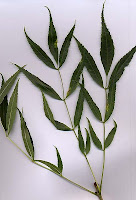Generally we don’t think of trees when we think of desert. By definition deserts are dry, with the potential to lose much more moisture than they receive, and trees, given their size, need lots of water. But trees have their strategies. Hiking the plateaus and canyons south of Grand Junction, Colorado, I found plenty of trees. Some are adapted to the desert environment; others simply avoid it.
 |
| Utah juniper on Entrada sandstone, western Colorado. |
The Utah juniper does quite well and is common in the high desert. It deals with arid conditions by way of adaptations that minimize evaporation, for example tough tiny leaves (scales) with a waxy coating. Junipers are evergreen and able to photosynthesize year-round, taking advantage of favorable conditions as they arise. And they grow slowly -- stunted gnarled trees may be among the oldest.
Utah juniper, Juniperus osteosperma, ranges from central Wyoming southwest to easternmost California. It is very common in Utah, Nevada and Arizona, often forming extensive stands with pinyon pine. Here the pinyon is all but absent; I saw only one on my hike. Rocky Mountain juniper (J. scopulorum) also grows in western Colorado, generally at higher elevations, but the two overlap in distribution. The yellowish-green color as well as lower elevation indicate that these are Utah junipers.
Right: Utah juniper happy in its sandstone alcove where water runs off the rock. Note its luxurious growth (for a juniper) and abundant berries. Juniper berries (photo below) are eaten by birds and small mammals, and serve as flavoring for gin.
Junipers are commonly called “cedars”, though they are not true cedars (the genus Cedrus). Cedar Breaks National Monument in southwest Utah is named for the Utah junipers that grow in the breaks.
In contrast with the tough junipers, other “desert" trees avoid arid conditions by growing
where more water is available. Desert washes look dry much of the year, but often there is water fairly close to the surface, within root-reach. Tree cover often is greater in washes.
The tree above caught me by surprise when I first saw it in a desert wash years ago. I was puzzling over some large shrubs and small trees with simple oval leaves when I came across one in fruit. It had the distinctive one-winged fruits of ash trees! But could this be an ash? with only simple leaves instead of the compound ones typical of the genus?? and growing in the desert??? Yes! ... evolution has reduced the compound leaf to a single leaflet, hence the name. The scientific name suggests that botanist who first described this tree was surprised as well: Fraxinis anomala.
Left: "typical" ash branch with 3 compound leaves with 7 leaflets each. Photo by MPF, via Wikimedia Commons.
Single-leaf ash, Fraxinis anomala, is a tree of the high-deserts of western North America. It grows from westernmost Colorado, where this photo was taken, west to easternmost California and south into northern Arizona and the northwest corner of New Mexico. It is also called dwarf ash.
 |
| Single-leaf ash, with single-winged fruits characteristic of ash trees. |
The Fremont cottonwood above indicates water is nearby. These desert cottonwoods only grow where there is water very close to the surface and soils are wet. A concrete water tank nearby confirmed my suspicions. Fremont cottonwood, Populus fremontii, is common in the Southwest and throughout California. It is easy to propagate, and has been widely planted. These trees grow fast but are short-lived.
I found my tree by flipping through the leaf photos in the “toothed simple leaves section”. This is a Siberian elm, native to Asia from Turkestan to eastern Siberia and northern China. Since introduction to the United States, Siberian or Asian elm (Ulmus pumila) has become widely-naturalized (escaped and established) from Minnesota south to Kansas and west to Utah. It doesn’t need as much water as its relatives, but even so, it avoids true desert habitat. Here it probably is tapping into subsurface water that accumulates along the buried sandstone.










No comments:
Post a Comment